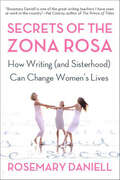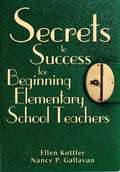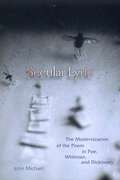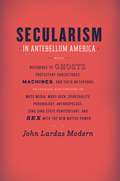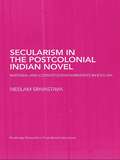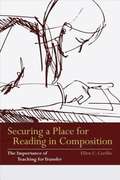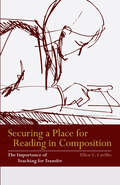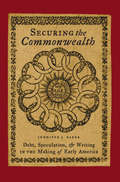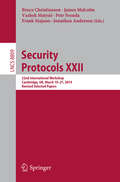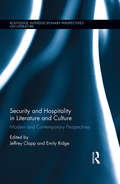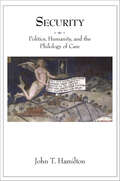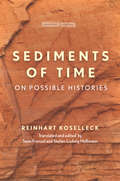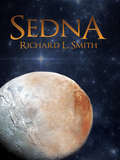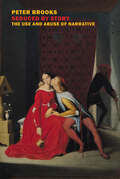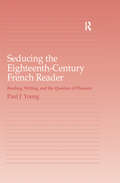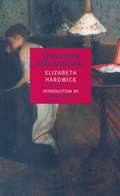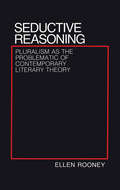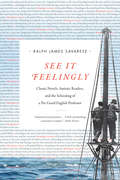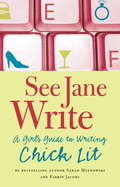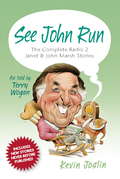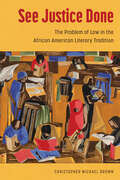- Table View
- List View
Secrets of the Oracle
by W. David ShawWhat is wisdom? Where does it come from? Where can we find it? And what does it mean in our lives? In Secrets of the Oracle, David Shaw explores these questions by turning to the works of wisdom writers, whose words retain their meaning and transformative power even centuries after they were written.Wisdom literature exists in two shaping forms - the aphorism, geared towards the past, and the oracle, a revolutionary impulse looking to the future. Secrets of the Oracle discusses both types of wisdom, finding them in the works of poets and philosophers from Tennyson and Zeno to Yeats and George Berkeley, from Browning and Schleiermacher to T.S. Eliot and F.H. Bradley. The book also discusses the contribution to wisdom of Jesus and the author of Ecclesiastes, of Abraham Lincoln and Norman Maclean. Part celebration of wisdom found and part lament for wisdom lost, Secrets of the Oracle is convincing in its assertion that wisdom articulates what is and offers creative visions of the future.
Secrets of the Tattooed Girl: The Unauthorised Guide to the Stieg Larsson Trilogy
by Dan Burstein John-Henri Holmberg Arne de KeijzerA fascinating companion to Stieg Larsson's bestselling MILLENNIUM series, revealing the secrets behind the phenomenon that has taken the world by storm.From the team that brought you the bestselling SECRETS OF THE CODE comes the first literary companion to Stieg Larsson's worldwide phenomenon, piecing together the puzzles that make Larsson's series so outrageously popular. Through insightful commentary and revealing interviews, you enter the unique world of Lisbeth Salander, Mikael Blomkvist, and of Stieg Larsson himself - discovering the fascinating real-life characters and incidents at the heart of Larsson's work.- What is the truth about Stieg Larsson's tragic death at age 50, just before publication of his novels?- Did Larsson leave behind a fourth book manuscript and plot outlines for his planed ten-book series?- Is Lisbeth the first true literary heroine of the 21st century?- What changes were made in the plots and translations of the novels after Larsson's death - and why?- What will happen in the contentious battle between Larsson's life partner, Eva Gabrielsson, and his father and brother over his billion dollar legacy, and more importantly, the future of his characters, plots and ideas?These questions, and many more, will be answered in this gripping and insightful book about the man who has changed the face of crime fiction this century.
Secrets of the Zona Rosa: How Writing (and Sisterhood) Can Change Women's Lives
by Rosemary DaniellAn inspiring guide featuring the wit, wisdom, and stories of Zona Rosa, the writing-and-sisterhood workshop that has empowered thousands of womenFor more than twenty years, Rosemary Daniell—Southern belle, successful writer, and tireless champion of female empowerment—has led Zona Rosa, a writing workshop for women founded on the premise that writing can be not only a creative challenge but a tool for healing. Here, she shares the secrets of Zona Rosa: practical advice and home-grown "Exorcises" that help you face and think through writing issues, and life in general.You'll learn how to avoid the "13 (Possible) Boo Boos" that plague everyone's writing. You'll bring yourself to "Write About the Thing I Most Don't Want to Write About" and learn how facing the difficult past can lead to breakthroughs. You'll discover "The Emotional Tai Chi of Getting Your Work Out There," with suggestions for painlessly sending your work into the world. Along the way, you'll meet some of the many women who have improved their writing—and lives—through the camaraderie, constructive advice, and fun of Zona Rosa. And you'll be inspired by Rosemary Daniell herself, who has weathered personal tragedy, Bad Love, and her own writing issues to come out singing. Secrets of the Zona Rosa is essential reading for any woman who writes—and who has lived a life full of stories.
Secrets to Success for Beginning Elementary School Teachers
by Ellen Kottler Nancy P. GallavanPacked with insider tips, practical strategies, and time-tested advice, this invaluable guide is designed for new and preservice educators. Offering a wide range of perspectives, authors Ellen Kottler and Nancy P. Gallavan cover the essential topics that novice teachers encounter, including establishing routines and classroom rules, planning instruction and assessment techniques, networking with colleagues, navigating school policies and procedures, and communicating effectively with parents. Tools and resources include:Steps for developing meaningful curriculum Activities to extend learning and apply ideas in the classroomPreparation guidelines and checklistsLesson plan formatsStrategies for including technologyServing as a virtual “mentor,” this handbook combines the insights of experienced teachers with straightforward portrayals of what to expect during the first days, weeks, semesters, and years in the classroom. Reduce your stress, improve your skills, and assure your success with this extraordinary resource.
Secular Lyric: The Modernization of the Poem in Poe, Whitman, and Dickinson
by John MichaelSecular Lyric interrogates the distinctively individual ways that Poe, Whitman, and Dickinson transformed classical, romantic, and early modern forms of lyric expression to address the developing conditions of Western modernity, especially the heterogeneity of believers and beliefs in an increasingly secular society. Analyzing historically and formally how these poets inscribed the pressures of the modern crowd in the text of their poems, John Michael shows how the masses appear in these poets’ work as potential readers to be courted and resisted, often at the same time. Unlike their more conventional contemporaries, Poe, Whitman, and Dickinson resist advising, sermonizing or consoling their audiences. They resist most familiar senses of meaning as well. For them, the processes of signification in print rather than the communication of truths become central to poetry, which in turn becomes a characteristic of modern verse in the Western world. Poe, Whitman, and Dickinson, in idiosyncratic but related ways, each disrupt conventional expectations while foregrounding language’s material density, thereby revealing both the potential and the limitations of art in the modern age.
Secularism in Antebellum America (Religion And Postmodernism Ser.)
by John Lardas ModernGhosts. Railroads. Sing Sing. Sex machines. These are just a few of the phenomena that appear in John Lardas Modern’s pioneering account of religion and society in nineteenth-century America. This book uncovers surprising connections between secular ideology and the rise of technologies that opened up new ways of being religious. Exploring the eruptions of religion in New York’s penny presses, the budding fields of anthropology and phrenology, and Moby-Dick, Modern challenges the strict separation between the religious and the secular that remains integral to discussions about religion today. Modern frames his study around the dread, wonder, paranoia, and manic confidence of being haunted, arguing that experiences and explanations of enchantment fueled secularism’s emergence. The awareness of spectral energies coincided with attempts to tame the unruly fruits of secularism—in the cultivation of a spiritual self among Unitarians, for instance, or in John Murray Spear’s erotic longings for a perpetual motion machine. Combining rigorous theoretical inquiry with beguiling historical arcana, Modern unsettles long-held views of religion and the methods of narrating its past.
Secularism in the Postcolonial Indian Novel: National and Cosmopolitan Narratives in English (Routledge Research in Postcolonial Literatures)
by Neelam SrivastavaFirst Published in 2007. Routledge is an imprint of Taylor & Francis, an informa company.
Securing a Place for Reading in Composition
by Ellen C. CarilloSecuring a Place for Reading in Composition addresses the dissonance between the need to prepare students to read, not just write, complex texts and the lack of recent scholarship on reading-writing connections. Author Ellen C. Carillo argues that including attention-to-reading practices is crucial for developing more comprehensive literacy pedagogies. Students who can read actively and reflectively will be able to work successfully with the range of complex texts they will encounter throughout their post-secondary academic careers and beyond. Considering the role of reading within composition from both historical and contemporary perspectives, Carillo makes recommendations for the productive integration of reading instruction into first-year writing courses. She details a "mindful reading" framework wherein instructors help students cultivate a repertoire of approaches upon which they consistently reflect as they apply them to various texts. This metacognitive frame allows students to become knowledgeable and deliberate about how they read and gives them the opportunity to develop the skills useful for moving among reading approaches in mindful ways, thus preparing them to actively and productively read in courses and contexts outside first-year composition. Securing a Place for Reading in Composition also explores how the field of composition might begin to effectively address reading, including conducting research on reading, revising outcome statements, and revisiting the core courses in graduate programs. It will be of great interest to writing program administrators and other compositionists and their graduate students.
Securing a Place for Reading in Composition: The Importance of Teaching for Transfer
by Ellen C. CarilloSecuring a Place for Reading in Composition addresses the dissonance between the need to prepare students to read, not just write, complex texts and the lack of recent scholarship on reading-writing connections. Author Ellen C. Carillo argues that including attention-to-reading practices is crucial for developing more comprehensive literacy pedagogies. Students who can read actively and reflectively will be able to work successfully with the range of complex texts they will encounter throughout their post-secondary academic careers and beyond. Considering the role of reading within composition from both historical and contemporary perspectives, Carillo makes recommendations for the productive integration of reading instruction into first-year writing courses. She details a “mindful reading” framework wherein instructors help students cultivate a repertoire of approaches upon which they consistently reflect as they apply them to various texts. This metacognitive frame allows students to become knowledgeable and deliberate about how they read and gives them the opportunity to develop the skills useful for moving among reading approaches in mindful ways, thus preparing them to actively and productively read in courses and contexts outside first-year composition. Securing a Place for Reading in Composition also explores how the field of composition might begin to effectively address reading, including conducting research on reading, revising outcome statements, and revisiting the core courses in graduate programs. It will be of great interest to writing program administrators and other compositionists and their graduate students.
Securing the Commonwealth: Debt, Speculation, and Writing in the Making of Early America
by Jennifer J. BakerSecuring the Commonwealth examines how eighteenth-century American writers understood the highly speculative financial times in which they lived. Spanning a century of cultural and literary life, this study shows how the era's literature commonly depicted an American ethos of risk taking and borrowing as the peculiar product of New World daring and the exigencies of revolution and nation building. Some of the century's most important writers, including Cotton Mather, Benjamin Franklin, Royall Tyler, Charles Brockden Brown, and Judith Sargent Murray, believed that economic and social commonwealth—and one's commitment to that commonwealth—might be grounded in indebtedness and financial insecurity. These writers believed a cash-poor colony or nation could not only advance itself through borrowing but also gain reputability each time it successfully paid off a loan. Equally important, they believed that debt could promote communality: precarious public credit structures could exact popular commitment; intricate financial networks could bind individuals to others and to their government; and indebtedness itself could evoke sympathy for the suffering of others. Close readings of their literary works reveal how these writers imagined that public life might be shaped by economic experience, and how they understood the public life of literature itself. Insecure times strengthened their conviction that writing could be publicly serviceable, persuading readers to invest in their government, in their fellow Americans, and in the idea of America itself.
Security Protocols XXIII
by Jonathan Anderson Bruce Christianson Petr Švenda Vashek Matyáš James Malcolm Frank StajanoThis book constitutes the thoroughly refereed post-workshop proceedings of the 23rd International Workshop on Security Protocols, held in Cambridge, UK, in March/April 2015. After an introduction the volume presents 18 revised papers each followed by a revised transcript of the presentation and ensuing discussion at the event. The theme of this year's workshop is "Information Security in Fiction and in Fact".
Security and Hospitality in Literature and Culture: Modern and Contemporary Perspectives (Routledge Interdisciplinary Perspectives on Literature)
by Emily Ridge Jeffrey ClappWith contributions from an international array of scholars, this volume opens a dialogue between discourses of security and hospitality in modern and contemporary literature and culture. The chapters in the volume span domestic spaces and detention camps, the experience of migration and the phenomena of tourism, interpersonal exchanges and cross-cultural interventions. The volume explores the multifarious ways in which subjects, citizens, communities, and states negotiate the mutual, and potentially exclusive, desires to secure themselves and offer hospitality to others. From the individual’s telephone and data, to the threshold of the family home, to the borders of the nation, sites of securitization confound hospitality’s injunction to openness, gifting, and refuge. In demonstrating an interrelation between ongoing discussions of hospitality and the intensifying attention to security, the book engages with a range of literary, cultural, and geopolitical contexts, drawing on work from other disciplines, including philosophy, political science, and sociology. Further, it defines a new interdisciplinary area of inquiry that resonates with current academic interests in world literature, transnationalism, and cosmopolitanism.
Security: Politics, Humanity, and the Philology of Care (Translation/Transnation #34)
by John T. HamiltonFrom national security and social security to homeland and cyber-security, "security" has become one of the most overused words in culture and politics today. Yet it also remains one of the most undefined. What exactly are we talking about when we talk about security? In this original and timely book, John Hamilton examines the discursive versatility and semantic vagueness of security both in current and historical usage. Adopting a philological approach, he explores the fundamental ambiguity of this word, which denotes the removal of "concern" or "care" and therefore implies a condition that is either carefree or careless. Spanning texts from ancient Greek poetry to Roman Stoicism, from Augustine and Luther to Machiavelli and Hobbes, from Kant and Nietzsche to Heidegger and Carl Schmitt, Hamilton analyzes formulations of security that involve both safety and negligence, confidence and complacency, certitude and ignorance. Does security instill more fear than it assuages? Is a security purchased with freedom or human rights morally viable? How do security projects inform our expectations, desires, and anxieties? And how does the will to security relate to human finitude? Although the book makes clear that security has always been a major preoccupation of humanity, it also suggests that contemporary panics about security and the related desire to achieve perfect safety carry their own very significant risks.
Sediments of Time: On Possible Histories (Cultural Memory in the Present)
by Stefan-Ludwig Hoffmann Reinhart Koselleck Sean FranzelSediments of Time features the most important essays by renowned German historian Reinhart Koselleck not previously available in English, several of them essential to his theory of history. The volume sheds new light on Koselleck's crucial concerns, including his theory of sediments of time; his theory of historical repetition, duration, and acceleration; his encounters with philosophical hermeneutics and political and legal thought; his concern with the limits of historical meaning; and his views on historical commemoration, including that of the Second World War and the Holocaust. A critical introduction addresses some of the challenges and potentials of Koselleck's reception in the Anglophone world.
Seditious Allegories: John Thelwall and Jacobin Writing
by Michael ScrivenerThe multifaceted career of John Thelwall (1764-1834)—poet, novelist, playwright, journalist, politician, scientist—is the lens through which we are offered here a new look at the phenomenon of British Jacobinism, long distorted by the critical view of it as intellectually weak bequeathed to us by Coleridge and Wordsworth, once Jacobins themselves. This book, the first on Thelwall in almost one hundred years, combines literary analysis and historical description to show how this innovative political activist remained true to his radicalism while adapting his methods in the face of the anti-Jacobin reaction that Paine's The Rights of Man helped set off.The three parts of the book set Thelwall's achievements and challenges in the political and literary context of his times. Part One, "Jacobin(s) Writing," focuses on the most essential aspects, ideologically and formally, of the insurgent writing of the 1790s to which Thelwall contributed. Part Two, "The Voice of the People," treats both Thelwall's radical oratory and journalism, as well as his writings and activities as a natural scientist and rhetorician, a professor and technician of "elocution." Part Three, "Jacobin Allegory," expounds on Thelwall's characteristic strategy of indirect expression through synecdoche and allegory, which he used in his later career after repression forced him out of politics.Through Thelwall's life Michael Scrivener succeeds in revealing how British Jacobinism reshaped the public sphere, initiating numerous literary experiments with oratory, pamphlets, periodicals, popularizations, and songs in the spaces opened up by political associations, lectures, meetings, and trials. Jacobinism thus altered the very institutions of reading and writing by expanding literacy, restructuring the popular arena for reading, and generating a body of diverse texts that were "seditious allegories."
Sedna
by Richard L. SmithThe year is 2117. The United World Science Foundation has sanctioned a team of geologists to explore the remote minor planet known as Sedna. About one-half the diameter of Pluto, Sedna orbits twice as faraway from Earth as Pluto is, and at this distance, it receives only weak sunlight and is dark, cold, and forbidding. Discovered in the first decade of the twenty first century, the first astronauts landed on its surface in 2087. This geological team will be the first scientists to explore the surface of this remote icy world. Astronomers have been unable to explain the unusual mass, density, and gravitational attraction measured for such a small dwarf planet. The two hemispheres are dramatically different, one side similar to our moon while the other side is more like the surface of Mars. In 2104, Sedna became the home of the Sedna International Observatory. After years of construction, in 2014 its 30-meter telescope saw first light and immediately began making important discoveries. The seven-year geological mission to Sedna on starship Tesla includes a year to explore and chart the dwarf planet to answer those puzzling geological mysteries. The novel follows these scientists as they journey through our solar system, explore Sedna, and discover “something wonderful” on its surface. Technical problems on their three-year journey home forces unscheduled landings on Triton and Mars yet provides unforgettable opportunities to visit these unique worlds. An unanticipated revelation awaits them upon their return home.
Seduced by Story: The Use and Abuse of Narrative
by Peter BrooksIn this spiritual sequel to his influential Reading for the Plot, Peter Brooks examines the dangerously alluring power of storytelling.&“There&’s nothing in the world more powerful than a good story. Nothing can stop it. Nothing can defeat it.&” So begins the scholar and literary critic Peter Brooks&’s reckoning with today&’s flourishing cult of story. Forty years after publishing his seminal work Reading for the Plot, his important contribution to what came to be known as the &“narrative turn&” in contemporary criticism and philosophy, Brooks returns to question the unquestioning fashion in which story is now embraced as an excuse or explanation and the fact that every brand or politician comes equipped with one. In a discussion that ranges from The Girl on the Train to legal argument, Brooks reminds us that among the powers of narrative is the power to deceive.
Seducing the Eighteenth-Century French Reader: Reading, Writing, and the Question of Pleasure
by Paul J. YoungAs he demonstrates that narratives of seduction function as a master plot for French literature in the eighteenth century, Paul Young argues that the prevalence of this trope was a reaction to a dominant cultural discourse that coded the novel and the new practice of solitary reading as dangerous, seductive practices. Situating his study in the context of paintings, educational manuals, and criticism that caution against the act of reading, Young considers both canonical and lesser-known works by authors that include Rousseau, Sade, Bastide, Laclos, Crébillon fils, and the writers of two widely read libertine novels. How these authors responded to a cultural climate that viewed literature, and especially the novel, as seductive, sheds light on the perils and pleasures of authorship, the ways in which texts interact with the larger cultural discourse, and what eighteenth-century texts tell us about the dangers of reading or writing. Ultimately, Young argues, the seduction not in the text, but by the text raises questions about the nature of pleasure in eighteenth-century French literature and culture.
Seduction and Betrayal: Women and Literature
by Joan Didion Elizabeth HardwickThe novelist and essayist Elizabeth Hardwick is one of contemporary America's most brilliant writers, and Seduction and Betrayal, in which she considers the careers of women writers as well as the larger question of the presence of women in literature, is her most passionate and concentrated work of criticism. A gallery of unforgettable portraits--of Virginia Woolf and Zelda Fitzgerald, Dorothy Wordsworth and Jane Carlyle--as well as a provocative reading of such works as Wuthering Heights, Hedda Gabler, and the poems of Sylvia Plath, Seduction and Betrayal is a virtuoso performance, a major writer's reckoning with the relations between men and women, women and writing, writing and life.
Seductive Reasoning: Pluralism as the Problematic of Contemporary Literary Theory
by Ellen RooneySeductive Reasoning takes a provocative look at contemporary Anglo-American literary theory, calling into question the critical consensus on pluralism's nature and its status in literary studies. Drawing on the insights of Marxist and feminist critical theory and on the works of Althusser, Derrida, and Foucault, Rooney reads the pluralist’s invitation to join in a "dialogue" as a seductive gesture. Critics who respond find that they must seek to persuade all of their potential readers. Rooney examines pluralism as a form of logic in the work of E. D. Hirsch, as a form of ethics for Wayne Booth, as a rhetoric of persuasion in the books of Stanley Fish. For Paul de Man, Rooney argues, pluralism was a rhetoric of tropes just as it was, for Fredric Jameson, a form of politics.
See It Feelingly: Classic Novels, Autistic Readers, and the Schooling of a No-Good English Professor (Thought in the Act)
by Ralph James Savarese“We each have Skype accounts and use them to discuss [Moby-Dick] face to face. Once a week, we spread the worded whale out in front of us; we dissect its head, eyes, and bones, careful not to hurt or kill it. The Professor and I are not whale hunters. We are not letting the whale die. We are shaping it, letting it swim through the Web with a new and polished look.”—Tito Mukhopadhyay Since the 1940s researchers have been repeating claims about autistic people's limited ability to understand language, to partake in imaginative play, and to generate the complex theory of mind necessary to appreciate literature. In See It Feelingly Ralph James Savarese, an English professor whose son is one of the first nonspeaking autistics to graduate from college, challenges this view. Discussing fictional works over a period of years with readers from across the autism spectrum, Savarese was stunned by the readers' ability to expand his understanding of texts he knew intimately. Their startling insights emerged not only from the way their different bodies and brains lined up with a story but also from their experiences of stigma and exclusion. For Mukhopadhyay Moby-Dick is an allegory of revenge against autism, the frantic quest for a cure. The white whale represents the autist's baffling, because wordless, immersion in the sensory. Computer programmer and cyberpunk author Dora Raymaker skewers the empathetic failings of the bounty hunters in Philip K. Dick's Do Androids Dream of Electric Sheep? Autistics, some studies suggest, offer instruction in embracing the nonhuman. Encountering a short story about a lonely marine biologist in Antarctica, Temple Grandin remembers her past with an uncharacteristic emotional intensity, and she reminds the reader of the myriad ways in which people can relate to fiction. Why must there be a norm? Mixing memoir with current research in autism and cognitive literary studies, Savarese celebrates how literature springs to life through the contrasting responses of unique individuals, while helping people both on and off the spectrum to engage more richly with the world.
See Jane Write
by Sarah Mlynowski Farrin JacobsWith chick lit novels popping up on every bestseller list, millions of readers are all thinking the same thing: I could write this stuff. I could write a bestseller and never go back to the office again! And here's the guide that will show you how. Bestselling novelist Sarah Mlynowski and veteran chick lit editor Farrin Jacobs cover every stage of developing and selling your soon-to-be bestselling novel, with information on * developing an idea * learning the basics of plotting * deciding on a point of view * pacing, and conflict * making your characters likable * finding an agent --and much more, including humorous tips and advice from scores of established writers (from Meg Cabot and Marian Keyes to Emily Giffin and Sophie Kinsella). If you've got stories to tell, See Jane Write will take care of the rest!
See John Run
by Kevin JoslinFor the last four years, 8 million listeners to BBC Radio 2's Wake Up To Wogan have been beguiled and bewitched by the naughty but nice adventures of John and his wife Janet. In the style of children's stories of yesteryear, John gets up to all sorts. Then he tells Janet all about his day, by which time every perfectly innocent big end, back passage and stiff one acquires a whole new meaning... After selling over a quarter of a million recordings of their adventures, they're now available in hard covers for the first time.
See Justice Done: The Problem of Law in the African American Literary Tradition (Margaret Walker Alexander Series in African American Studies)
by Christopher Michael BrownIn See Justice Done: The Problem of Law in the African American Literary Tradition, author Christopher Michael Brown argues that African American literature has profound and deliberate legal roots. Tracing this throughline from the eighteenth century to the present, Brown demonstrates that engaging with legal culture in its many forms—including its conventions, paradoxes, and contradictions—is paramount to understanding Black writing.Brown begins by examining petitions submitted by free and enslaved Blacks to colonial and early republic legislatures. A virtually unexplored archive, these petitions aimed to demonstrate the autonomy and competence of their authors. Brown also examines early slave autobiographies such as Olaudah Equiano’s Interesting Narrative and Mary Prince’s History, which were both written in the form of legal petitions. These works invoke scenes of Black competence and of Black madness, repeatedly and simultaneously.Early Black writings reflect how a Black Atlantic world, organized by slavery, refused to acknowledge Black competence. By including scenes of Black madness, these narratives critique the violence of the law and predict the failure of future legal counterparts, such as Plessy v. Ferguson, to remedy injustice. Later chapters examine the works of more contemporary writers, such as Sutton E. Griggs, George Schuyler, Toni Morrison, and Edward P. Jones, and explore varied topics from American exceptionalism to the legal trope of "colorblindness." In chronicling these interactions with jurisprudential logics, See Justice Done reveals the tensions between US law and Black experiences of both its possibilities and its perils.
See Me: Prison Theater Workshops and Love
by Jan Cohen-CruzEncounters, transformations, and reflections from in-prison and post-release theater workshopsSee Me is a collection of intimate dialogues about collective experiences in the context of prison theater workshops. Each essay is a collaboration between two or three people who connected profoundly in the temporary community that a workshop can create. Part I is an exchange grounded in the prison theater workshop between the author and one of the incarcerated participants. They alternately tell the story of what they found in the workshop, each other, the future they imagined together, and the social turmoil and utopian aspirations of the times. Part II consists of essays jointly written by eight other people impacted by close relationships spawned in diverse in-prison and re-entry theater workshops.


